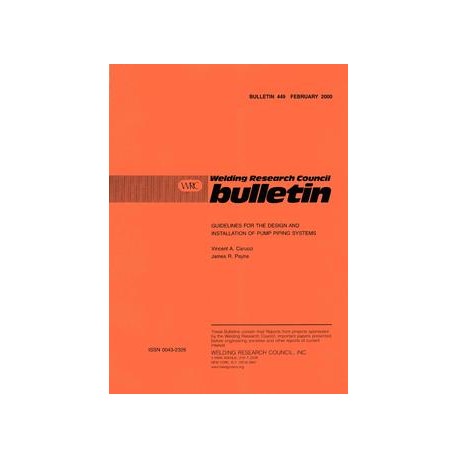Cart
0
Product
Products
(empty)
No products
To be determined
Shipping
$0.00
Total
Product successfully added to your shopping cart
Quantity
Total
There are 0 items in your cart.
There is 1 item in your cart.
Total products
Total shipping
To be determined
Total
New
Reduced price!
 View larger
View larger
 View larger
View larger
WRC 449
M00009602
New product
WRC 449 Guidelines For The Design And Installation Of Pump Piping Systems
Bulletin / Circular by Welding Research Council, 2000
V. A. Carucci, J. R. Payne
In stock
More info
Full Description
Where piping systems interact with load sensitive equipment it is likely that the allowed interface reactions will govern the pipe system design. Unrealistically low allowable reactions may increase piping system cost while excessively high reactions may increase equipment maintenance costs. The cooperative best efforts of pump and piping designers are needed to arrive at the most cost effective pump piping system on a life cycle basis.Excessive piping reactions at pumps cause high vibration, coupling failures, and pump shaft misalignment. In severe cases there are flanged joint leaks and the occasional occurrence of impeller rub or casing distortion. Excessive shaft misalignment in turn leads to premature seal and bearing failures. These difficulties are a costly maintenance item that can also result in plant shutdowns, and in severe cases, fires and extensive damage. This guide presents industry practices intended to minimize these difficulties while keeping capital and life cycle costs in perspective.
A survey prompted by industry inquiries was conducted to establish an experience base about the effect of pipe reactions on centrifugal pumps, the nature of the problems experienced, the standards and criteria used to design and install pump piping systems, and industry attitudes on the issue. The survey concentrated on the experience and needs of piping and pump system designers, specifiers, manufacturers, and operators. It was designed to help the PVRC determine, among other things, its research priorities in these areas.
The survey results confirmed that a pump nozzle load problem exists, and that it has significant cost impact on industry. This impact was in two broad areas: Operating and maintenance costs, such as: shutdowns caused by excessive vibration, cracks or deformation to casings, flange leaks and coupling failures; capital project costs, such as those accruing from a poor understanding of required pump strength and piping load criteria before pump purchase.
The purpose of this Guide is to: Establish recommended practices and guidelines for pump piping system design, layout, installation and alignment for the process and power industries; Provide consistent recommended allowable pipe reaction and pump strength criteria where none exist at present.
This Guide was developed mainly by assembling and documenting the most appropriate practices currently in use by the process and power industries for various services. The guidelines are mainly broad-based and considered standard engineering practice. Nevertheless, new tolerances are suggested for pipe to pump flange alignment of critical piping systems and new allowable pipe reaction and pump strength criteria for situations where none presently exist.
Many of these guidelines apply with little modification to piping for other types of load sensitive equipment such as turbines, compressors and air fin heat exchangers. However, this Guide does not attempt to extend the information presented beyond centrifugal pumps.

